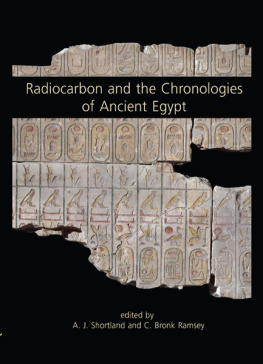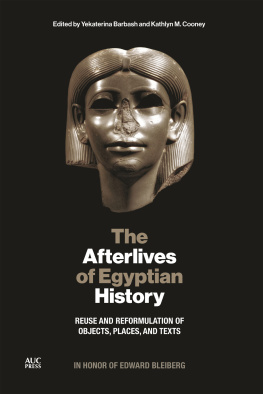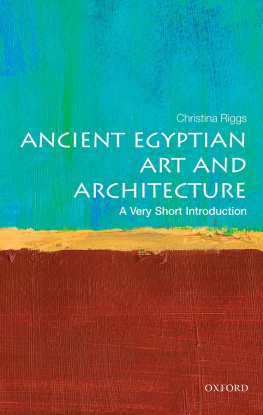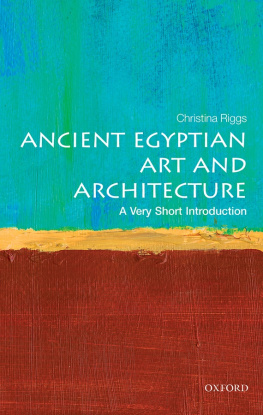Published by
Oxbow Books, Oxford, UK
Oxbow Books and the authors, 2013
ISBN 978-1-84217-522-4
EPUB ISBN: 978-1-78297-057-6
PRC ISBN: 978-1-78297-058-3
This book is available direct from:
Oxbow Books, Oxford, UK
(Phone: 01865-241249; Fax: 01865-794449)
and
The David Brown Book Company
PO Box 511, Oakville, CT 06779, USA
(Phone: 860-945-9329; Fax: 860-945-9468)
or from our website
www.oxbowbooks.com
A CIP record for this book is available from the British Library
Library of Congress Cataloging-in-Publication Data
Radiocarbon and the chronologies of ancient Egypt / edited by Andrew J. Shortland
and C. Bronk Ramsey.
p. cm.
Includes bibliographical references.
ISBN 978-1-84217-522-4
1. Egypt--History--To 332 B.C. 2. Egypt--History--To 332 B.C.--Chronology. 3.
Radiocarbon dating--Egypt. 4. Egypt--Antiquities. I. Shortland, Andrew J. II. Bronk
Ramsey, Christopher.
DT83.R194 2013
932.01--dc23
2013011013
Cover image: Part of a king-list from the Temple of Ramesses II at Abydos, 19th Dynasty.
The Trustees of the British Museum, EA117, AN32689
Printed in Great Britain by
Short Run Press
Exeter
Contents
K. A. Kitchen |
A. J. Shortland |
C. Bronk Ramsey |
F. Brock and M. W. Dee |
F. Brock |
M. W. Dee |
M. W. Dee |
M. Bietak |
F. Hflmayer, A. Hassler, W. Kutschera and E. M. Wild |
S. W. Manning, B. Kromer, M. W. Dee, M. Friedrich, T. F. G. Higham and C. Bronk Ramsey |
Aidan Dodson |
S. McAleely |
J. H. Taylor |
M. W. Dee |
E. S. Marcus |
M. W. Dee |
M. Brta |
E. C. Khler |
J. M. Rowland |
Preface
The ideas behind this book have their origins in discussions held in the University of Oxfords Research Laboratory for Archaeology and the History of Art back in the 1990s. Due to the space constraints imposed by having a large university within an old city, with very high property prices, sharing offices was essential. In his wisdom, Mike Tite, then the Professor of Archaeological Science, thought it a very good thing that a radiocarbon scientist with a background in physics and a materials scientist with a strong interest in Egypt should be in the same room. And so it was, through the inevitably overheard conversations, and through discussion of issues, far from our usual research, we came to see that there was interesting research to be done in the application of radiocarbon in Egypt. It was some time, and only after we had moved offices and changed jobs, that we finally managed to do something with these ideas, thanks to a project funded by the Leverhulme Trust. The projects final form also owes much to the research coming from Manfred Bietaks SCIEM2000 project and to a radiocarbon dating project on papyri, conducted with the Oxford Radiocarbon Accelerator Unit which was led by Ezra Marcus.
Both the SCIEM2000 project and a major attempt by Georges Bonnani and colleagues to date monuments from Ancient Egypt, along with a whole series of projects looking at radiocarbon dating in relation to the Minoan eruption of Santorini, was that radiocarbon dating was not always in good agreement with prevailing archaeological interpretations of the chronology. It was far from clear whether this was due to problems with the chronologies, with the samples chosen for dating or indeed with radiocarbon dating itself.
Ezra Marcus brought to this the idea of using papyri from Egypt with known dates from the historical chronology to study this problem. By using many of these it should be possible to study the details of the radiocarbon record from Egypt. As it turned out this approach was, at that time, only possible for a very restricted timeframe. However, it was clear that the idea could be broadened out to looking at any radiocarbon dates that could be directly related to the political chronology of Egypt. By using the known order of kings, together with the new statistical methods now available for the analysis of radiocarbon dates, we could test the consistency of the radiocarbon measurements with the relatively well-known chronology of dynastic Egypt, especially in the New Kingdom.
The research project that provided the impetus to this book, was then primarily intended as a check of whether radiocarbon dating worked in Ancient Egypt, and discovering if not, why not. As we conducted the research, however, and gained an appreciation of the issues surrounding the chronologies of dynastic Egypt, it became clear that, at least for some periods, radiocarbon might be reaching the stage where it can help resolve some of the chronological debates. It was with much needed humility that we approach this, since there is such a wealth and depth of scholarship in this field that we could never hope to understand in all its intricacy. We are very grateful to Kenneth Kitchen for summarising some of this at the start of this volume. Overall this book brings together both a summary of the findings of our research group and the perspectives of others on these and on related issues.
This book is not intended to address all of the issues that there are in the use of radiocarbon dating in Egypt. It could not possibly hope to do so. What we hope it does is to look at the underlying question of whether radiocarbon dating has the capability to resolve some of the chronological questions that need to be answered to properly understand the relationship of Egypt to the other civilisations in the region. While there are many problems, perhaps principally the recycling and curation of materials, and the disturbance of contexts by succeeding generations, we think that it does. The challenge for the future is to sort out how radiocarbon can be best applied in the region, and how the issue of access to accelerator-based radiocarbon dating within Egypt can be addressed.
It is perhaps ironic that a project borne of an overcrowded office should concentrate on Egypt, where many of the issues in radiocarbon dating seem to stem from the tight constraints of the Nile Valley meaning that people lived, not only close to each other, but also often on top of the remnants left by previous generations, leaving a complex agglomeration of material from different periods. Only by careful, almost forensic analysis can we use radiocarbon in such a situation. We have learnt a lot from both the research we have undertaken over the last few years and from the contributions of our colleagues to this volume.
C. Bronk Ramsey and A. J. Shortland
Acknowledgements
This book would not have been possible without the help of Michael Dee and Fiona Brock in helping to manage the editing, and in organising the symposium that led directly to it. The research project that underlies our contributions achieved what it did only because of the dedication of those involved: in particular, Michael Dee as the doctoral student in the project, stands out and this is reflected by his contributions to this volume. Another important contribution was that of Joanne Rowland who did so much to locate and identify samples that would be useful for dating from museums around the world. Tom Higham also provided intellectual input throughout the project, particularly in understanding the issues in choosing samples for radiocarbon dating and understanding the implications of their results. Stephen Harris ensured that we understood what we were dating from a botanical point-of-view and helped locate more recent known-age material from the Oxford University Herbaria and the Natural History Museum, London. Anita Quiles and Eva Wild provided important cross checking of results with the radiocarbon laboratories of Saclay and Vienna.
Next page






